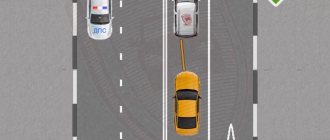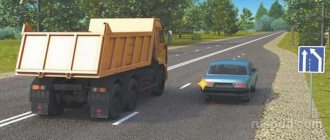Weather conditions suitable for changing tires
If you take into account only weather conditions, it is recommended to adhere to the following rules:
- dry or wet road - summer or all-season tires;
- road covered with snow - winter;
- road covered with ice - studded.
But it is recommended to install winter tires before the snow falls, also taking into account the ambient temperature. As a rule, on the tires themselves, the manufacturer independently indicates the optimal conditions for their operation - they should be adhered to. In most cases, winter tires retain their properties at temperatures of +7 °C or below, and summer tires retain their properties at temperatures of +7 °C or above.
What happens if you use summer tires in the cold? It will lose its elasticity, the tread will be excessively hard, which will cause poor grip on the road surface. And when performing a maneuver, there is a high risk of slipping or skidding.
With winter everything is a little different. At temperatures above +7 °C it becomes too soft. The grip on the road surface is excellent, but the tread wears out very quickly. Accordingly, in such conditions, tires can only be used for 3–4 months, after which their further use is dangerous.
Viatti Brina Nordico
The combination of advanced technology and high-quality rubber alloy guarantees the asymmetrical tire excellent performance and durability.
The model is distinguished by reinforced blocks on the outside, which is confirmed by the inscription Outside. At the same time, the direction of the spikes is also visible - upon careful examination, the central part of the working surface is elongated in the direction of movement of the machine.
When to change tires to winter according to Russian law
The Russian traffic regulations do not clearly indicate when tires need to be changed. There are only the following requirements:
- during the period from December to February inclusive, winter tires with the appropriate marking must be installed on a motor vehicle (vehicle);
- the use of studded tires in any period other than winter is prohibited;
- The tread pattern of the front and rear wheels must be identical;
- It is prohibited to install studded tires only on the front or rear wheels, even if the car has only one drive axle;
- the residual depth of the pattern on a winter or studded tire must be more than 4 mm; if less, operation of the vehicle is prohibited until the malfunction is eliminated.
The news has repeatedly talked about the submission of a bill to the State Duma, according to which an exact period for mandatory tire replacement will be established, but so far there has been no progress in resolving this issue.
Tire installation. How to properly install tires on a car.
Car tires are one of the most important and critical elements of a car, on which traffic safety directly depends.
Therefore, the installation of tires on the car must be done correctly.
Despite the simplicity of the work of mounting tires, in many workshops, out of ignorance or laziness, tire fitters manage to install them incorrectly on the car.
Modern tires have several parameters that need to be clarified before installing them on a car:
- type of tread pattern
- where is the inner and where is the outer side of the tire
- on which side of the car the tire can be installed - on the right or on the left
Tread pattern type and direction of rotation
Most modern tires have a directional tread pattern, the direction of rotation of which is usually indicated by an arrow on the sidewall of the tire.
Therefore, installation of tires with a directional pattern can only be done in a strictly defined position, which must be clarified before installing them on the car.
A minority of modern tires have a non-directional tread pattern. These tires can be installed on either side.
You can find out exactly the type of tire tread pattern and its direction of rotation from the salesperson in the store.
Inner and outer side of the tire
A tire may have an inner and outer side if its tread pattern is not symmetrical.
The inner side of the tire is indicated by the indication “Inside”; this side of the tire should be installed inside the car in the direction of its movement.
The outer side of the tire is indicated by the indication “Outside”; this side of the tire should be installed outside the car in the direction of its movement.
Such installation restrictions are associated with the characteristics of the tire tread, which drains water most effectively only when the tire is installed correctly.
“Right” and “left” sides of tires
Some car tires are developed for a specific car model, or for a group of identical models.
In this case, tire manufacturers can specify on which side of the car the tire can be installed “Left” - on the left, “Right” - on the right.
What tires are suitable for winter
According to current laws, in winter it is allowed to operate vehicles with the following types of tires:
- winter ones with appropriate markings;
- studded;
- all-season, if there is a marking allowing operation in winter.
However, all-season tires, as practice shows, provide poorer traction with the road surface in the cold season. At the legal level, there are no fines for their use, but experienced drivers do not recommend using them from a safety point of view.
What is the difference between a winter tire and an all-season tire? The latter has a less pronounced and branched pattern. And in composition it is more similar to summer tires; on snowy or icy roads, traction deteriorates significantly.
Types of tire tread patterns
Modern tires are divided into three types depending on the design of the tread. The difference in the pattern allows manufacturers to adjust the characteristics of the product to certain road conditions.
Also, the shape of the pattern affects the noise and wear resistance of the slope.
Rubber without pattern direction
Typically, such rubber is intended for agricultural machinery and off-road vehicles. A non-directional pattern is the simplest and most cost-effective type, capable of working equally regardless of the rolling side.
The disadvantages include loud noise during acceleration and mediocre stability at high speeds.
Rubber with directional symmetrical pattern
A popular type of tread, used primarily for winter tires.
Thanks to the abundance of moisture drainage, the slopes hold up well on wet roads and are resistant to aquaplaning. The “V”-shaped pattern makes minimal noise and holds the road well. A nuance is the requirement for correct installation (strictly in the direction of the arrow). If you break the rule, loss of characteristics and accelerated wear are possible.
Tires with asymmetric pattern in direction
The asymmetrical directional tread is the most difficult to produce.
Thanks to this design, the tire combines cornering stability and optimal grip on straight sections. The improved performance of hybrid technology guarantees an advantage on the race track. For the average user, the advantages are not noticeable - at low speeds in city mode, the slopes cannot reveal their full potential.
Rules for using winter tires
Inexperienced drivers are advised to install studded tires a little earlier than expected, when the average daily ambient temperature drops to 8–9 °C. But when the roads are completely covered with snow or ice, it is better to use studded ones. This should not be used on clean asphalt - the stability of the car decreases, and you get a kind of skating effect.
You should not skimp on winter tires, and it is better to use all four wheels. Before the first trip, you need to make sure that it is working, that is, the tread depth is suitable, the pattern is uniform, and there is no asymmetric wear.
But as for storage, the best conditions for winter tires are garage conditions, but in a dry box or room. And be sure to protect from direct sunlight.
What tires are better to use before the onset of cold weather? The best option is a winter one, but it would be a good idea to take anti-slip chains with you. But in many countries it is completely prohibited to use studded tires - if you try to go through customs, you will receive a ban.
To sum up the correct and incorrect way to install directional tires on a car
So, the direction of the tread grooves on the tire was not just invented for beauty. If they exist, then it is better to use them. Directional tread grooves help drain fluid from under the wheel and thereby improve contact between the rubber and the road. Therefore, pay attention to the correct installation of the tire. When installing a tire, you need to pay attention to its tread. Moreover, such a statement applies not only to those who put an already wrapped wheel on a car, but also to mechanics who install the tire on a rim. After all, a car should have two wheels on the left side and two on the right. No other way! Well, about the case when the operation is carried out with incorrectly installed tires. If it's dry outside, there won't be any difference. If the street is not slushy or it has rained, then be extremely careful. It will be very difficult to get the car out of hydroplaning, and you don’t have to talk about the sad results. You yourself know everything about this without us.
Tips for installing winter tires
When is the best time to install winter tires? The generally accepted “folk” date is November 15. But this is only relevant for regions located in the temperate climate zone. Otherwise, they are guided by weather conditions and the average daily ambient temperature.
Before installing winter tires, it is recommended to have the wheels balanced. It is even better to carry out maintenance of the entire suspension.
You should also give preference to stamped steel disks - they do not get clogged with snow so quickly. It is advisable to install protective plastic caps of a closed type.
Thus, the car should be “shoeed” according to the season. Not because a fine may be issued for violating this rule, but for the safety of the road user himself. But there are no all-season tires suitable for use in the Russian Federation. Scientists have not yet been able to develop rubber that would retain its same elasticity at temperatures from -30 to +80 °C.
What liability will the violator face?
The Code of Administrative Offenses regulates that for deviation from technical standards in 2021, motorists will be subject to a financial penalty in the amount of 500 rubles. This measure is recorded in the first part of Article 12.5 of the Code of Administrative Offenses of the Russian Federation.
However, sometimes a traffic police officer may show leniency and demand that the cause of the violation be eliminated. The owner of the vehicle is given 10 days to do this. As proof of elimination, the driver is obliged to provide the State Traffic Inspectorate with a vehicle for inspection. In this situation, the car owner is required to show a vehicle with identical tires.
If the employee's requirement is violated, the vehicle registration will be cancelled. As a result, the violator’s vehicle will be put on the wanted list. After this, any stop by an employee will inevitably lead to the evacuation of the vehicle to a penalty area and the confiscation of the registration certificate and license plates.
However, the situation described in relation to tires with different patterns does not happen so often. Typically, a requirement to eliminate the cause of the violation is allowed when tinting a car or committing illegal tuning. It is also possible to receive a removal request if the owner, for example, modified his vehicle to a Bigfoot car.
You need to have an idea: the driver’s obligation to install a certain type of tires is fixed in paragraph 5.5 of the traffic rules.










